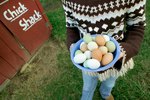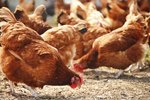
Turning to backyard chickens for eggs is neat, but choosing the right ones is complicated. It is important to know which chickens will give you the greatest number of eggs for the expense of keeping them. You'll also consider size, temperament and general health when choosing breeds for your flock.
High Production Breeds
If your main concern is to get a steady supply of eggs, you will not do better than the leghorn. This old heritage breed is a standard for most commercial poultry operations since leghorn hens will usually lay an egg daily except during molting. The leghorn is usually white but may also be brown or other colors. The leghorn lays pure white eggs, usually about 300 per year. Other chickens used for egg production include the hybrid sex-linked varieties – red stars and black stars, primarily – whose sex can be determined at an early age by the feather color. Sex-linked breeds, as hybrids, will not breed true in successive generations. The Hy-line brown and golden comet are other popular and productive hybrids. All but the leghorn lay large, brown eggs.
Great Non-Hybrid Brown Egg Layers
Ask any poultry keeper which chicken breed consistently lays the most brown eggs and you will get one of two answers: the Rhode Island Red or the Plymouth Rock. On occasion, someone may mention the Australorp -- an Australian breed created by careful selection from the black Orphington breed -- or the Barred Rock, which is only a color variation of the Plymouth Rock. But the Rhode Island Red and the Plymouth Rock are generally considered tops among brown egg layers. In addition, both breeds are hardy, friendly and productive even under less-than-perfect conditions. The Plymouth Rock is also a broody hen; that's something to keep in mind if you want to increase your flock naturally.
Other White Egg Layers
The Sussex, a very old English breed, is a beautiful bird that will lay around 260 to 280 eggs each year -- not quite as productive as the leghorn, but still a very acceptable number. The eggs are not so startlingly white as those of the leghorn, they're more cream-colored and brownish. The Sussex makes a good brood hen. The Ancona, originally from Italy, is a good producer of white eggs that lays longer in winter than many other breeds. The California grey originated back in the 1930s as a cross between the leghorn and the barred Plymouth Rock, with the great egg-laying capacity of both breeds.
Ornamental Egg-Laying Breeds and Unusually Colored Eggs
For an ornamental yet productive backyard flock, include a lovely silver Lakenvelder hen of German origin or a gold- or silver-spangled Hamburg. All of these pretty metallic-looking birds produce good quantities of white or very lightly tinted eggs. Araucana and Ameraucana, popularly known as Easter egg chickens, lay eggs in a variety of blues. It produces a moderately good number of large eggs ranging from olive green through pale blue and sometimes pinkish-tan, although the truest type lays pale blue eggs. The Sicilian buttercup is another exceedingly pretty pheasantlike hen with a unique cup-shaped comb. She lays lightly tinted eggs. The several color variants of French Marans are beautiful in the backyard flock, and the lovely chocolate-colored eggs add exotic variety to the egg basket.
References
Resources
Photo Credits
-
Jupiterimages/Photos.com/Getty Images




